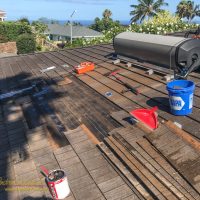A leak in my wife’s sewing room? She is not happy with water dripping on her sewing machine.
The leak is right under the solar hot water panels. Hmmm, is one of the mounting points leaking? This might be a PITA to fix.
Getting up on the roof and inspecting reveals this is not likely the case, there is another likely cause… ants. Just under the panel I find that a few shingles are in bad shape, and there are Hawaiian carpenter ants scurrying about when I break away a bit of the failed shingle.
It appears that the cooler environment under the solar panels was to the ants liking and they moved in. A downside to solar panels I had not considered.
This is not the first Hawaiian carpenter ant colony we have had to hunt down and kill, but so far the most damaging. The university extension service notes that Hawaiian carpenter ants are not usually destructive, at least not in comparison to the mainland variety, the colonies are small and do not really chew up that much. Unless they chew through the tar paper on your roof.
The damaged shingles are another problem, the ants keep the colony moist by bringing in water, a few of the old composite shingles are soft and fall apart in my hands. These three decade old shingles are no longer manufactured, finding a replacement is next to impossible. I have to come up with another solution.
A run to Home Depot to get the needed supplies and wait a week for a day without high winds or forecast rains. Eventually I have a free morning and good weather. I start before sunrise to avoid the worst of the day’s heat.
Draining 80 gallons of very hot water from the tank is fun. Closing the cutoff valves and opening the drain valve sees a stream of steaming hot water cascading from the roof. Even my neighbor notices, we chat as the tank drains.
The panels are fairly easy to remove. A few fittings to disconnect and the heavy panels are moved to above the tank. I cover them with a tarp to keep them cool in the hot sunlight else they may become quite hot, heating the remaining water in them without the siphon action moving the water about.
When I get the first few shingles removed I find the leak right where I expect it… Sure enough, several neat little holes chewed through the tar paper. Dozens of ants everywhere, scurrying about with pupae and eggs as I break into the colony.
I was prepared for the ants… Meet my shop-vac. Yes, I had the vacuum ready when the first shingles came up, extension cord strung across the the roof. As soon as a shingle comes up I vacuum up all the ants in sight. When reassembling everything I spray it down with a persistent insecticide, under the tarpaper, under the shingles, and again around the panels after I get everything back together.
The damage is not really as bad as I feared. Only a handful a holes in the tar paper. The biggest issue is the shingles that need to be replaced. Of the two gallons of asphalt patching compound I have ready I only end up using a bit less than one gallon. Most of that is used as a generous blob around every nail I replace in the older shingles and around the mounting points for the panels when putting the lower mounting rail back in place.
The replacement shingles are the standard asphalt shingles available at any home improvement store. They are close to the same size and easy to work with. I use the new shingles under the solar panels where they will not be seen. To cover a few places that the repaired section extends out from under the panels I use the best of the old shingles that I had removed.
As a result the repair cannot be seen from more than a few feet away, all looking good despite the mismatched shingles. The entire roof will eventually need to be replaced, the shingles are getting old. But that is still a few years off, maybe a decade, but no more than that.
The mounting rail goes back into place after re-locating the original mounting holes. The panels are little issue to replace after that, wrestle them back into place, reconnect the plumbing and opening up the various cutoff valves, bleeding the air from the tank and letting it refill. I hope the water warms up soon, I really need a shower at this point.
A week later we have an evening of steady rain… no leaks. Call this one a victory.




U allways need a shower lol. Keep deb happy
Aloha